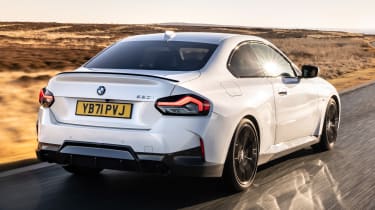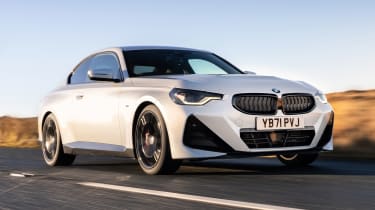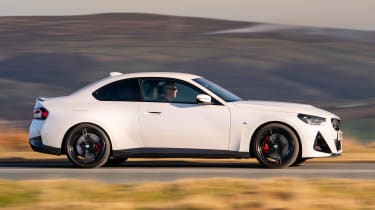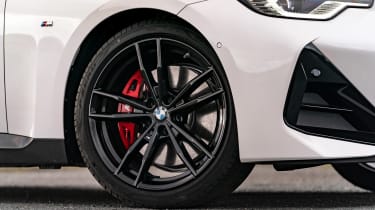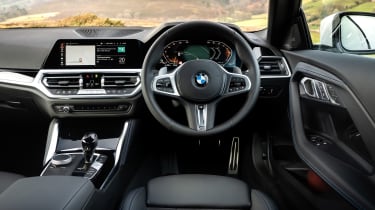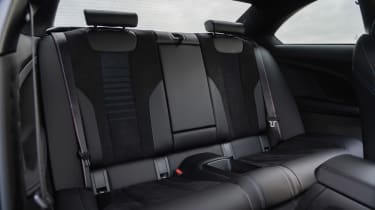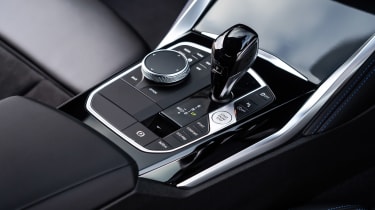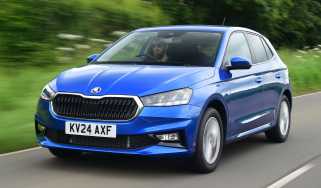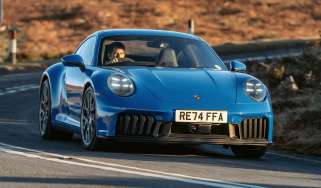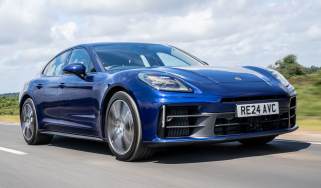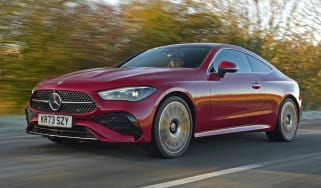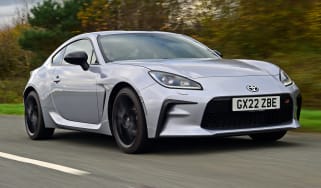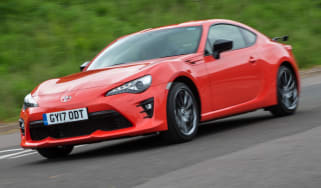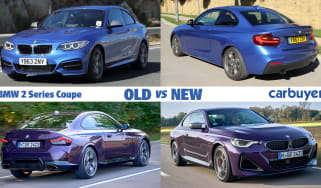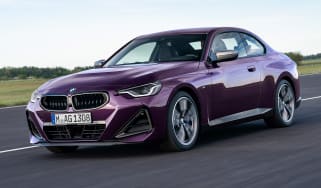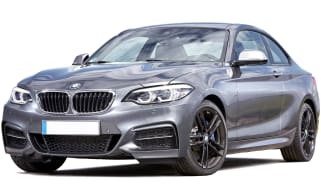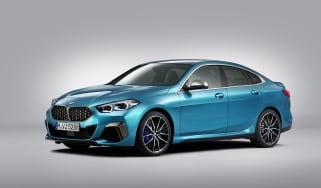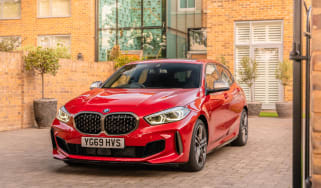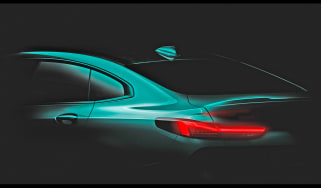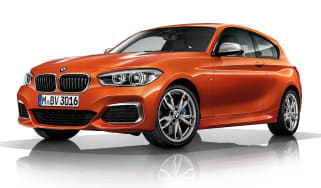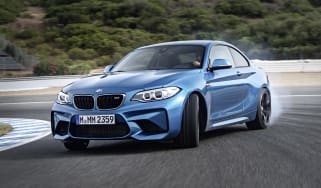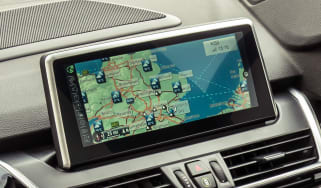BMW 2 Series Coupe review
"The BMW 2 Series Coupe offers sports car thrills with four seats and a fairly big boot"
Pros
- Fun to drive
- Potent engines
- Reasonable practicality
Cons
- No cheaper trims
- Limited engine range
- Tight access to back seats
The small coupe class is shrinking fast, so an all-new BMW 2 Series Coupe is big news for fans of sporty two-door models. There's no direct replacement in sight for the ageing Audi TT – Audi has considered everything from electric coupes to a TT SUV – and Mercedes no longer offers a small coupe. The Toyota GR86 is a more affordable alternative, although it’s now sold out in the UK, while buyers keen on the hot BMW M240i xDrive may also have sports cars like the Porsche 718 Cayman and Toyota GR Supra in their sights.
Loyal BMW fans who've been put off the BMW 4 Series Coupe by its growth spurt may be tempted by its smaller sibling, which has a more traditional look and overall shape. That's not to say the design isn’t modern; new headlights with integrated LED daytime running lights and lots of sharp angles and gloss black exterior trim keep it looking smart, if a little over-designed in places.
 The top 10 best sports cars in 2025
The top 10 best sports cars in 2025
Clearly targeted at keen drivers, the 2 Series Coupe will only be offered in M Sport trim in the UK and you'll need to look elsewhere if you want a hybrid or electric car. There's a 2.0-litre diesel badged 220d for high-mileage drivers (it can average around 60mpg), along with a handful of petrol options. Even the entry-level 220i has rear-wheel drive, 181bhp and an automatic gearbox, so it can get from 0-62mph in a brisk 7.5 seconds. BMW expects six in 10 buyers to choose this model.
More reviews
Above the 220i and more-powerful 230i is the range-topping M240i xDrive, which is the fastest 2 Series, aside from the high-performance M2. With a 3.0-litre six-cylinder petrol, it boasts 369bhp and four-wheel drive, which gets it from 0-62mph in a rapid 4.3 seconds - matching the aforementioned Supra and the original M2. With a chassis derived from the BMW 4 Series, the small BMW also feels controlled, secure and just engaging enough to keep keen drivers interested.
Digital instruments and a widescreen infotainment display ensure there's plenty of ways to stay connected and stream media on the move. You sit low in highly adjustable sports seats, and there's even a reasonable amount of room in the back seats. Far from just being a weekend car, a 390-litre boot also means the 2 Series Coupe should be easy to live with or take on a short break without having to pack light.
Inside, the 2 Series Coupe shares more in common with the BMW 3 Series and 4 Series than the 2 Series Gran Coupe saloon and Active Tourer MPV. The dashboard is very similar, which makes the 2 Series Coupe look great value alongside the more expensive 4 Series.
Times are changing for BMW, as more customers move into SUVs, plug-in hybrids and all-electric models. The result is that the 2 Series Coupe feels like a car for BMW's more hardcore and traditional fans, taking the technology and motors from its executive range and shoehorning them into a smaller car for maximum performance.
MPG, running costs & CO2
While it might be an all-new model, the 2 Series Coupe is aimed predominantly at keen drivers, so the engine range is made up of traditional petrols and diesels. All are turbocharged to improve efficiency and the diesel benefits from 48-volt mild-hybrid technology.
For high-mileage, long-distance drivers, it's the 220d diesel that's likely to make most sense, thanks to its headline figures of 60.1mpg and 122-132g/km of CO2 emissions. This places it in a middling band for Benefit-in-Kind (BiK) paying company-car drivers.
If you often take shorter trips, or just like the idea of driving the 2 Series Coupe for fun, the 220i is a good fit. It can still return up to 44.1mpg but its emissions of 145-149g/km are better suited to private buyers, as they result in a fairly hefty BiK bill. The more-powerful 230i returns slightly worse figures, but it’s a small tradeoff for the extra grunt that’s under the bonnet.
The high-performance M240i xDrive is, of course, thirstier still, being the fastest version of the 2 Series until a new BMW M2 arrives. It has a 3.0-litre turbocharged six-cylinder engine borrowed from the BMW 4 Series, with figures of 34.9mpg and 200g/km. That’s about the same as a hot hatchback, so even this model shouldn’t prove galactically expensive to run.
Engines, drive & performance
The 2 Series Coupe uses a shortened version of the underpinnings used for the BMW 3 Series saloon and 4 Series Coupe, which is hardly a bad place to start – both are at the top of their class. It also means BMW has stuck with rear-wheel drive, or four-wheel drive in the case of the range-topping M240i xDrive.
While its big 3.0-litre six-cylinder petrol engine may seem like an old-school choice in a new model, the M240i’s musical exhaust note can't be matched by rivals. The car feels taut and purposeful from the moment you set off, and early exploration of the engine's ability reveals the sort of addictive acceleration found in small cars with oversized engines. With 369bhp it feels a cut above most hot hatchbacks, and can get from 0-62mph in just 4.3 seconds, aided by its four-wheel drive traction.
There's no sense that the M240i is unruly or lacking in composure but there's almost always more power than you need, and the eight-speed automatic gearbox works smoothly behind the scenes. In Comfort mode, the suspension is composed and the new model's increased length and width helps it feel planted and stable. If there's a weakness, it's the steering, which feels rather vague and only gets heavier in Sport mode without being any more communicative.
For the majority of drivers, the lower rungs of the 2 Series Coupe ladder will offer sufficient performance, with all ‘lesser’ models coming with rear-wheel drive and an automatic gearbox as standard. The petrol 220i is fitted with a 2.0-litre turbo, producing 181bhp, which is enough for a 0-62mph time of 7.5 seconds and a 146mph top speed. While this won’t provide the same ‘kick in the back’ feeling as the more-powerful M240i under acceleration, the base car still offers a decent amount of punch, which makes getting up to motorway speeds feel relaxed.
Perhaps the sweet spot in the range is the new 230i model; this utilises a tuned version of the 220i’s 2.0-litre four-cylinder engine, producing a heftier 242bhp. With around 60 more horses under the bonnet than the 220i, the sprint from 0-62mph is cut down to just 5.9 seconds. With 100Nm more torque available at your right foot, the 230i feels a lot more urgent than its entry-level sibling.
Both the 220i and 230i feel incredibly agile and impressively keen to turn into corners. This is helped by the fact both are around 150kg lighter than the six-cylinder, all-wheel-drive M240i; less weight, rear-wheel-drive and an already finely-tuned chassis all make the cheapest 2 Series models the most involving from behind the wheel.
Finally, there’s the oddball of the range: the 220d diesel. Don’t discount it yet, as with 187bhp and 400Nm of torque, it’s more powerful than the base 220i. From a standstill, the 2 Series diesel will reach 62mph in a respectable 6.9 seconds and go onto a top speed of 147mph. With the best fuel economy figures here and a mountain of torque available for high-speed overtaking manoeuvres, the 220d is the best choice for long-distance cruising.
Interior & comfort
BMW sees its latest Coupe as a rival to models like the Audi TT and Toyota GR Supra, so it's only offered in M Sport trim. This comes with an aggressive body styling kit, complete with gloss black side skirts, air intakes, a rear bumper diffuser and subtle rear lip spoiler. A set of 18 or 19-inch alloy wheels and dual exhausts also set the scene, and the sporty theme continues inside.
Highly-adjustable seats are trimmed in Alcantara and Sensatec artificial leather upholstery, which is black by default but can also be chosen in three more distinctive colours. The dashboard is shrunken-down 4 Series, with the same 12.3-inch instrument display and 10.25-inch infotainment screen running BMW's iDrive 7 software.
Cars ordered as of Summer 2022 will instead get BMW’s latest iDrive 8 setup which features a Curved Display panel, comprising a 12.3-inch digital instrument cluster and an expansive 14.9-inch touchscreen. The only annoyance with this arrangement is that the climate controls are now integrated into the touchscreen, making them more difficult to operate when on the move. Regardless of whether you go for a car with the new or the old setup, both are compatible with Apple CarPlay, Android Auto and Amazon Alexa.
Options include a £1,200 Technology Pack that adds upgraded Bluetooth, wireless smartphone charging, a Wi-Fi hotspot and parking assistant. A Comfort Pack, for a similar price, adds extra seat adjustment that's electrically operated, a heated steering wheel, keyless entry, illuminated door handles, a digital key and welcome lighting.
Practicality & boot space
While some rivals like the Porsche 718 Cayman only offer room for two, there's a pair of seats in the back of the 2 Series Coupe. The main issue is getting into them because you'll need to move the front seats out of the way and clamber inside, which wouldn't be the easiest of tasks in a tight parking spot. Room isn't too bad once in the back but it's best suited to children or shorter adults. There are two ISOFIX points for child car seats.
Elsewhere, the interior has the storage you'd expect to find in a BMW, from the glovebox and central cubby between the front seats, to a storage area ahead of the gear lever and shallow door bins. There's also a surprisingly large 390-litre boot, which is 20 litres bigger than before. Not only that, but the loading lip has been lowered by a couple of inches to make it easier to lift heavy shopping bags and suitcases inside. The Audi TT has just 305 litres behind the rear seats and a much higher load lip to lift items over.
Reliability & safety
While the 2 Series Coupe is too new to have appeared in our Driver Power survey, the latest 3 Series performed well, voted into 31st-place out of the top 75 cars by owners. It received a middling score for reliability and build quality, but results were solid elsewhere. Owners were particularly impressed with its engines, gearboxes and infotainment setup. Considering the two cars share so much technology, this looks promising for the smaller model.
Given that the 2 Series Coupe shares parts with the the larger BMW 3 Series, we’d have liked to see the 2 Series receive the same five-star Euro NCAP result. The 2 Series got a four-star score, with good figures for adult and child protection but only okay ratings for pedestrian protection and its safety features.
Driver aids like autonomous emergency braking are fitted as standard. Meanwhile, the Technology Plus Pack adds all-round cameras that can provide a drone-like aerial view of the car, along with Drive Recorder, which can record exterior footage in an incident, replacing the need for an aftermarket dash cam.
Which Is Best?
Cheapest
- Name220i M Sport 2dr Step Auto
- Gearbox typeSemi-auto
- RRP£38,710
Most Economical
- Name220i M Sport 2dr Step Auto
- Gearbox typeSemi-auto
- RRP£38,710
Fastest
- NameM240i xDrive 2dr Step Auto
- Gearbox typeSemi-auto
- RRP£48,875

